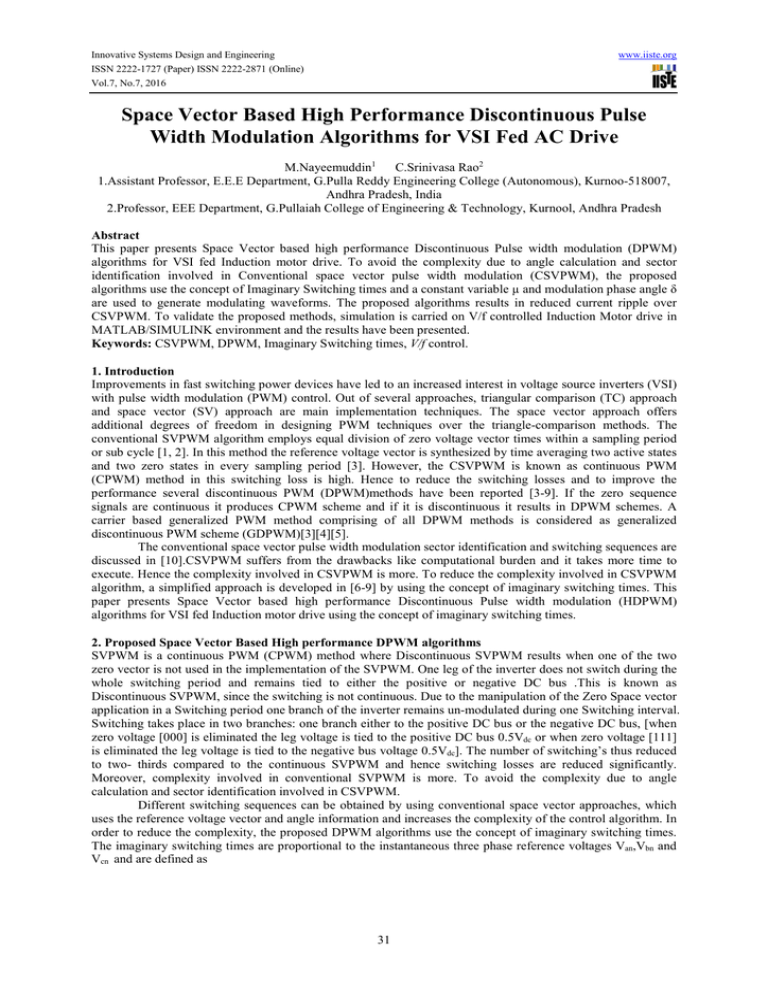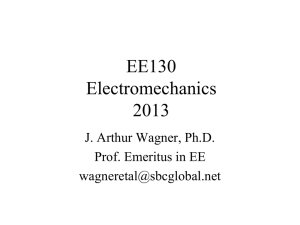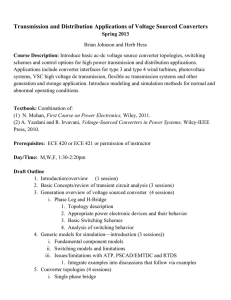Space Vector Based High Performance Discontinuous Pulse
advertisement

Innovative Systems Design and Engineering ISSN 2222-1727 (Paper) ISSN 2222-2871 (Online) Vol.7, No.7, 2016 www.iiste.org Space Vector Based High Performance Discontinuous Pulse Width Modulation Algorithms for VSI Fed AC Drive M.Nayeemuddin1 C.Srinivasa Rao2 1.Assistant Professor, E.E.E Department, G.Pulla Reddy Engineering College (Autonomous), Kurnoo-518007, Andhra Pradesh, India 2.Professor, EEE Department, G.Pullaiah College of Engineering & Technology, Kurnool, Andhra Pradesh Abstract This paper presents Space Vector based high performance Discontinuous Pulse width modulation (DPWM) algorithms for VSI fed Induction motor drive. To avoid the complexity due to angle calculation and sector identification involved in Conventional space vector pulse width modulation (CSVPWM), the proposed algorithms use the concept of Imaginary Switching times and a constant variable µ and modulation phase angle δ are used to generate modulating waveforms. The proposed algorithms results in reduced current ripple over CSVPWM. To validate the proposed methods, simulation is carried on V/f controlled Induction Motor drive in MATLAB/SIMULINK environment and the results have been presented. Keywords: CSVPWM, DPWM, Imaginary Switching times, V/f control. 1. Introduction Improvements in fast switching power devices have led to an increased interest in voltage source inverters (VSI) with pulse width modulation (PWM) control. Out of several approaches, triangular comparison (TC) approach and space vector (SV) approach are main implementation techniques. The space vector approach offers additional degrees of freedom in designing PWM techniques over the triangle-comparison methods. The conventional SVPWM algorithm employs equal division of zero voltage vector times within a sampling period or sub cycle [1, 2]. In this method the reference voltage vector is synthesized by time averaging two active states and two zero states in every sampling period [3]. However, the CSVPWM is known as continuous PWM (CPWM) method in this switching loss is high. Hence to reduce the switching losses and to improve the performance several discontinuous PWM (DPWM)methods have been reported [3-9]. If the zero sequence signals are continuous it produces CPWM scheme and if it is discontinuous it results in DPWM schemes. A carrier based generalized PWM method comprising of all DPWM methods is considered as generalized discontinuous PWM scheme (GDPWM)[3][4][5]. The conventional space vector pulse width modulation sector identification and switching sequences are discussed in [10].CSVPWM suffers from the drawbacks like computational burden and it takes more time to execute. Hence the complexity involved in CSVPWM is more. To reduce the complexity involved in CSVPWM algorithm, a simplified approach is developed in [6-9] by using the concept of imaginary switching times. This paper presents Space Vector based high performance Discontinuous Pulse width modulation (HDPWM) algorithms for VSI fed Induction motor drive using the concept of imaginary switching times. 2. Proposed Space Vector Based High performance DPWM algorithms SVPWM is a continuous PWM (CPWM) method where Discontinuous SVPWM results when one of the two zero vector is not used in the implementation of the SVPWM. One leg of the inverter does not switch during the whole switching period and remains tied to either the positive or negative DC bus .This is known as Discontinuous SVPWM, since the switching is not continuous. Due to the manipulation of the Zero Space vector application in a Switching period one branch of the inverter remains un-modulated during one Switching interval. Switching takes place in two branches: one branch either to the positive DC bus or the negative DC bus, [when zero voltage [000] is eliminated the leg voltage is tied to the positive DC bus 0.5Vdc or when zero voltage [111] is eliminated the leg voltage is tied to the negative bus voltage 0.5Vdc]. The number of switching’s thus reduced to two- thirds compared to the continuous SVPWM and hence switching losses are reduced significantly. Moreover, complexity involved in conventional SVPWM is more. To avoid the complexity due to angle calculation and sector identification involved in CSVPWM. Different switching sequences can be obtained by using conventional space vector approaches, which uses the reference voltage vector and angle information and increases the complexity of the control algorithm. In order to reduce the complexity, the proposed DPWM algorithms use the concept of imaginary switching times. The imaginary switching times are proportional to the instantaneous three phase reference voltages Van,Vbn and Vcn and are defined as 31 Innovative Systems Design and Engineering ISSN 2222-1727 (Paper) ISSN 2222-2871 (Online) Vol.7, No.7, 2016 www.iiste.org The imaginary switching times are expressed as Where Ts is the sampling time period and Vdc is dc link voltage. If the instantaneous reference voltages are negative, the corresponding switching times will also be negative. Hence these times are called as imaginary switching times. In every sampling time, the maximum, minimum and medium values of imaginary switching times are calculated as [7-8]. Where max, min and mid are three nominal values used during the sampling interval. The function Max(Tas ,Tbs ,Tcs ), Min(Tas ,Tbs ,Tcs ) and mid(Tas ,Tbs ,Tcs ) select the maximum, minimum and middle values among Tas ,Tbs and Tcs. respectively. Actual gating signals for inverter can be generated by the time shifting operation as follows: Where In the proposed method µ can be defined as Where ω is angular frequency of reference voltage. When µ=0.5, µ=0 and µ= 1 the CSVPWM, DPWMMAX and DPWMMIN algorithms can be obtained. Similarly, the variation of modulation phase angle δ yields to infinite number of DPWM methods. If δ = -π/3, π/6, 0, - π/6 then DPWM1, DPWM2, DPWM3 and DPWM4 can be obtained respectively. Thus by varying µ and δ the switching time periods of zero voltage vectors can be changed and so that different DPWM sequences can be obtained. 32 Innovative Systems Design and Engineering ISSN 2222-1727 (Paper) ISSN 2222-2871 (Online) Vol.7, No.7, 2016 www.iiste.org The modulating waveforms of different DPWM sequences, SPWM and CSVPWM are as shown in Fig 1. DPWM sequences are obtained based on their clamping sequences. In DPWMMIN method, the clamping of 120 takes place at the middle of 180o– 360ofor every 360o of fundamental voltage. In DPWMMAX method, the clamping of 120o takes place at the middle of 0o-180o for every 360o of fundamental voltage. In DPWM1, the clamping of 60 takes place at the middle 0-180 for every 180 of fundamental voltage. In DPWM2 method, the clamping of 60 takes place at the start of 90-180 for every 180 of fundamental voltage. DPWM3 clamps every phase during the middle 30 for every 90 of its fundamental voltage. In DPWM4 method, the clamping of 60 takes place at the end of 0for every 180 of fundamental voltage. Figure-1 Modulating waveforms of different sequences (a) SPWM (b)SVPWM (c) DPWMMIN (d)DPWMMAX (e) DPWM1 (f) DPWM2 (g) DPWM3 (h) DPWM4 3. Results: To validate proposed Space Vector Based High Performance DPWM Algorithms, Simulation & Experimental tests on a constant v/f voltage source inverter fed induction motor drive have been conducted using Matlab/Simulink & d-Space Kit in the laboratory. DC link voltage 540 volts & 4.5 KHz switching frequency have been applied. Simulation and experimental results are shown in Figure 2 to Figure 23. The induction motor used in this case study is a 4 KW, 1430 rpm, 4-pole, 3-phase induction motor having the following parameters: Table-1 parameters of Induction motor Parameter Value Stator Resistance (Rs) 1.4 Ω Rotor Resistance (Rr) 1.39 Ω Magnetizing Inductance (Lm) 0.1722 H Stator Self Inductance (Ls) 0.005839 H Rotor Self Inductance (Lr) 0.005839 H Moment of inertia (J) 0.0131 Kg-m2 33 Innovative Systems Design and Engineering ISSN 2222-1727 (Paper) ISSN 2222-2871 (Online) Vol.7, No.7, 2016 www.iiste.org 3.1) Simulation Results: Fig 2. SPWM algorithm at Mi=0.81 Fig 3. SVPWM algorithm at Mi=0.81 Fig 4. DPWMMIN algorithm at Mi=0.81 34 Innovative Systems Design and Engineering ISSN 2222-1727 (Paper) ISSN 2222-2871 (Online) Vol.7, No.7, 2016 www.iiste.org Fig 5. DPWMMAX algorithm at Mi=0.81 Fig 5. DPWM1 algorithm at Mi=0.81 Fig 6. DPWM2 algorithm at Mi=0.81 35 Innovative Systems Design and Engineering ISSN 2222-1727 (Paper) ISSN 2222-2871 (Online) Vol.7, No.7, 2016 www.iiste.org Fig 7. DPWM3 algorithm at Mi=0.81 Fig 8. DPWM4 algorithm at Mi=0.81 3.2) EXPERIMENTAL RESULTS: Fig 9. SPWM algorithm at Mi=0.81: Modulating Signal, Pulses, Line Voltage and Stator Current 36 Innovative Systems Design and Engineering ISSN 2222-1727 (Paper) ISSN 2222-2871 (Online) Vol.7, No.7, 2016 www.iiste.org Fig. 10 SVPWM algorithm at Mi=0.81: Modulating Signal, Pulses, Line Voltage and Stator Current Fig 11. DMPWMMIN algorithm at Mi=0.81: Modulating Signal, Pulses, Line Voltage and Stator Current Fig 12. DMPWMMAX algorithm at Mi=0.81: Modulating Signal, Pulses, Line Voltage and Stator Current Fig 13. DMPWM1 algorithm at Mi=0.81: Modulating Signal, Pulses, Line Voltage and Stator Current 37 Innovative Systems Design and Engineering ISSN 2222-1727 (Paper) ISSN 2222-2871 (Online) Vol.7, No.7, 2016 www.iiste.org Fig 14. DMPWM2 algorithm at Mi=0.81: Modulating Signal, Pulses, Line Voltage and Stator Current Fig 15. DMPWM3 algorithm at Mi=0.81: Modulating Signal, Pulses, Line Voltage and Stator Current Fig 16. DMPWM4 algorithm at Mi=0.81: Modulating Signal, Pulses, Line Voltage and Stator Current 3.3. Stator Current Harmonic Comparison: Fig 17. SPWM: Harmonic distortion of line current along with THD at Mi=0.81 38 Innovative Systems Design and Engineering ISSN 2222-1727 (Paper) ISSN 2222-2871 (Online) Vol.7, No.7, 2016 www.iiste.org Fig 18. SVPWM: Harmonic distortion of line current along with THD at Mi=0.81 Fig 18. DPWMMIN: Harmonic distortion of line current along with THD at Mi=0.81 Fig 19. DPWMMAX: Harmonic distortion of line current along with THD at Mi=0.81 Fig 20. DPWM1: Harmonic distortion of line current along with THD at Mi=0.81 Fig 21. DPWM2: Harmonic distortion of line current along with THD at Mi=0.81 Fig 22. DPWM3: Harmonic distortion of line current along with THD at Mi=0.81 Fig 23. DPWM4: Harmonic distortion of line current along with THD at Mi=0.81 5. Conclusion The proposed space vector based High performance discontinuous PWM algorithms uses the concept of imaginary switching times. To avoid the complexity due to angle calculation and sector identification involved in Conventional SVPWM also the execution time and memory required is reduced by eliminating the angle and sector estimation. From the simulation results of V/f control of induction motor drive the total harmonic distortions of the motor phase current in Continuous SVPWM are more compared to the varoius DPWM sequences. The Total THD values for the proposed HDPWM algorithms are listed. It is observed that there is a 39 Innovative Systems Design and Engineering ISSN 2222-1727 (Paper) ISSN 2222-2871 (Online) Vol.7, No.7, 2016 www.iiste.org gradual decrement of the %THD in motor phase currents and also it is observed that in every fundamental cycle, DPWM modulating signal clamp to either negative dc bus or positive dc bus for a period of 120 degrees which results reduction in the switching losses of the inverter by 33.33%. Hence DPWM sequences give better performance. The simulation & Experimental results show the validity of the proposed algorithm. TABLE2: COMPARISON OF LINE CURRENT THD S.No PWM Algorithm 1 2 3 4 5 6 7 8 SPWM SVPWM DPWMMIN DPWMMAX DPWM1 DPWM2 DPWM3 DPWM4 THD in Line Current (%) At Mi=0.81 12.39 10.11 7.88 7.86 8.88 9.42 7.83 9.42 References [1] G.Narayanan, “Space vector based hybrid PWM Techniques for reduced current ripple,”IEEE, Trans, vol 55, No 4,april 2008. [2] G.Narayanan and V. T. Ranganathan, “Analytical evaluation of harmonic distortion in PWM AC drives using the notion of stator flux ripple,” IEEE Trans. Power Electronics., vol. 20, no. 2, pp. 466– 474, Mar. 2005. [3] K. Sri Gowri,”High-Performance Generalized ADPWM Algorithm for VSI Fed IM Drives for Reduced Switching Losses.”InternationalJournal of Recent Trends in Engineering, Vol 2, No. 5, November 2009 [4] Ahmet M.hava and Thomas “Simple Analytical and Graphical Methods for Carrier- based PWM-VSI Drives”, IEEE Trans on power electronics vol14 no1 jan 1999 [5] J.Holtz, ―Pulse width modulation for electronic power conversion, Proc. IEEE, vol82, no. 8, pp. 1194– 1214, Aug. 1994. [6] G.Satheesh, T. Bramhananda Reddy and Ch. Sai Babu ,”Novel SVPWM Algorithm for Open end Winding Induction Motor Drive Using the Concept of ImaginarySwitching Times.” International Journal of Advances in Science and Technology, Vol. 2, No.4, 2011, Page 44 of 92. [7] N.Ravisankar Reddy and T. Brahmananda Reddy “Simplified Space Vector Based Hybrid PWM Algorithm for Reduced CurrentRipple”,International Journal of Recent Trends in Engineering, Vol 2, No. 5, November 2009 [8] K. Zhou and D.Wang, “Relationship between space-vector modulation and three-phase carrier-based PWM: A comprehensive analysis,” IEEE Trans Ind. Electron., vol. 49, no. 1, pp. 186–196, Feb. 2002 [9] N.Praveena , G.Satheesh , R.Ramprasad“Space Vector Based PWM Algorithms to ReduceCurrent Ripple for an Induction Motor Drive ,”International Journal of Advanced Scientific and Technical Research, Volume 3, pp 528- 540, Feb 2013 [10] Advanced Bus-Clamping PWM Techniques Based on Space Vector Approach.G.Narayanan, Member, IEEE, Harish K. Krishnamurthy, Di Zhao, and RajapandianAyyanar, Member, IEEE,2006. Nayeemuddin.M had completed his B.Tech and M.Tech in 2005 and 2008 with first class in the department of Electrical and Electronics Engineering from J.N.T.University Hyderabad and Sri Krishna Devaraya. University Ananthapuramu respectively. Now he is pursuing his Ph.D in J.N.T. University, Ananthapuramu. He is working as a Assistant Professor in the Department of Electrical and Electronics Engineering. His scientific research is focusing on Power Electronics, and Motor Drive control. Dr. C.Srinivasa Rao had completed his B.Tech and M.E in 2002 and 2004 with first class in the department of Electrical and Electronics Engineering from J.N.T. University, Ananthapuramu and BITS, Mesra respectively. He obtained doctoral degree from J.N.T. University, Kakinada in 2010. He is working as a Professor and Head of the department of Electrical and Electronics Engineering in G.Pullaiah college Engineering & Technology , Kurnool. He presented more than 45 research papers in various national and international conferences and journals. His research areas include Soft computing techniques, Power systems operation and control. 40




